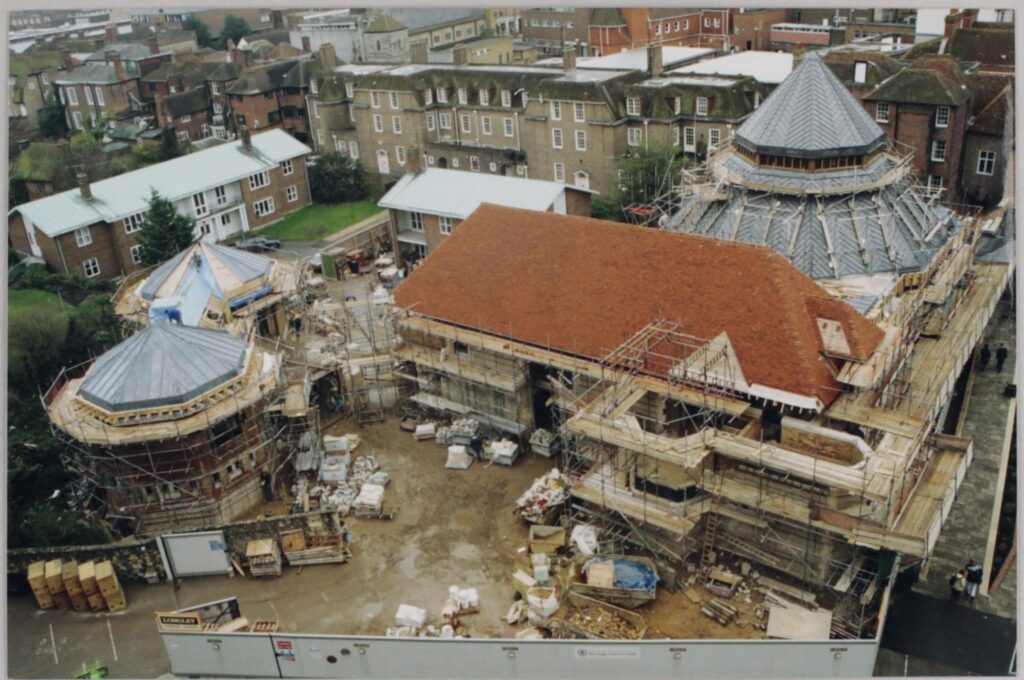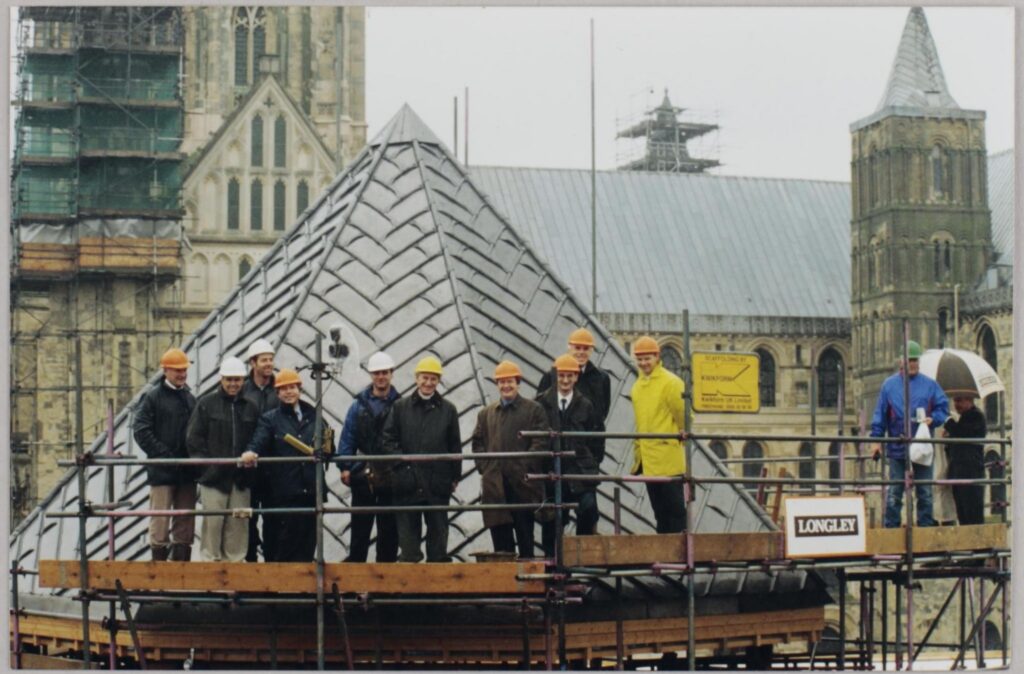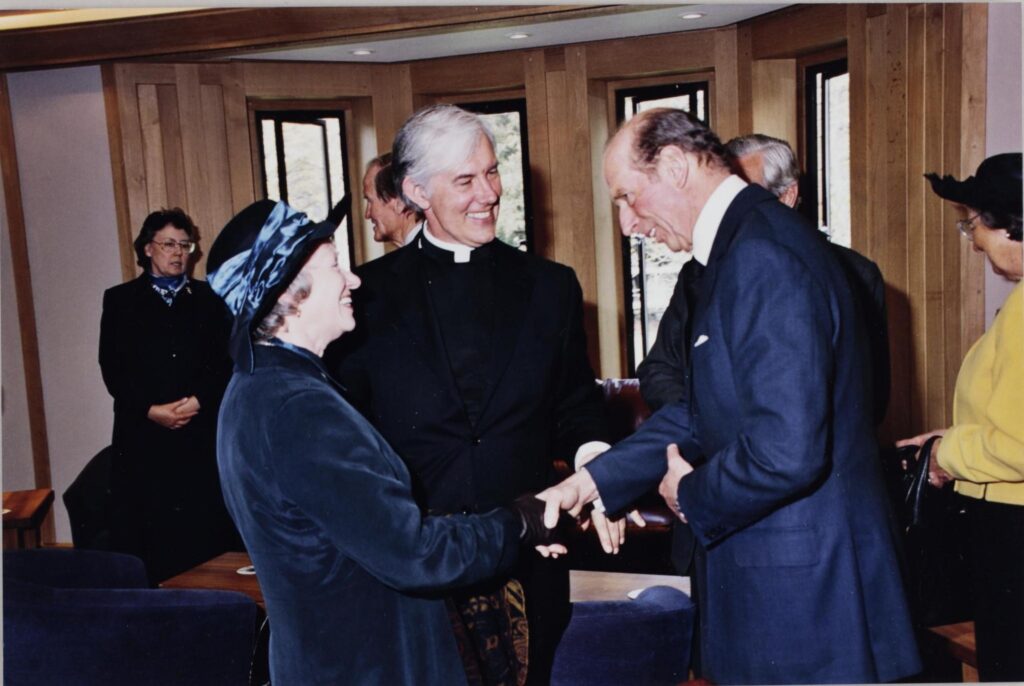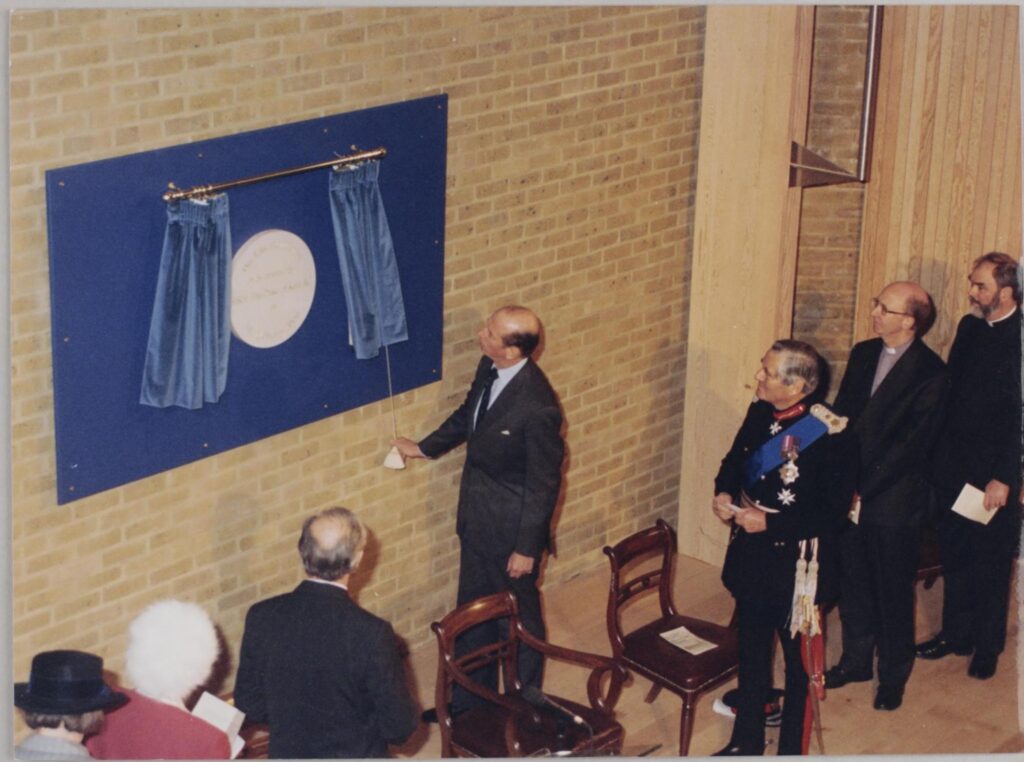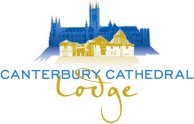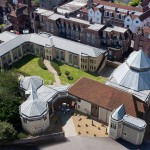History
The History of Canterbury Cathedral Lodge – a short history celebrating 22 years of success
The current Cathedral Lodge buildings (previously known as the International Study Centre, and also the Education Centre) were designed by Sir William Whitfield (1920-2019) and his architectural practice. Sir William was approached in 1990 for proposals for developing a site on the south side of The Precincts. This site was occupied by 1960s residential buildings, which had replaced buildings lost during the bombing of World War II in 1942. In the decades after the end of the War, there had been various discussions about the provision of buildings for education and hospitality on this site.
In addition to an education centre, the proposal from Sir William Whitfield included accommodation for conference and course delegates, and for visiting groups. Funding for the project was sought from 1995 onwards2. Much was raised by a campaign in the United States. The Heritage Lottery Fund3 gave a grant of £2.25 million in 1997. Various public bodies were approached for permission for the new buildings, the existing buildings were demolished, and archaeological digs were carried out. Construction started in 1998, with George Carey, Archbishop of Canterbury, laying the cornerstone during the Lambeth Conference of that year, as recorded on a carved stone slab. The first phase was completed in 2000, with the buildings opened by His Royal Highness the Duke of Kent on 18th January 2001. This phase of buildings included the auditorium, the lecture theatre and the buildings now housing the Schools Department.
The residential accommodation block was opened in 2002. It included a Refectory, a Common Room, and a Library. For the construction of this block, a roadway was laid along the back of Burgate House to link the site to the Postern Gate. This roadway remains in use for deliveries.
The buildings were designed to fit with their surroundings in The Precincts. Sir William Whitfield studied architecture at the Newcastle School of Architecture, then part of the University of Durham. From 1985 to 1990, Sir William held the position of Surveyor of the Fabric of St Paul’s Cathedral. In 1981, he designed the new Chapter House for St Albans Cathedral, and in 1996 the Mappa Mundi Library at Hereford Cathedral. The design of the Cathedral Lodge buildings shows Sir William’s interests in late gothic and Tudor architecture, with stylistic references to the Cathedral buildings themselves. The roofing on most of the buildings is of lead, reflecting the lead work on the Cathedral itself. The octagonal shapes mirror the octagonal shape of the Water Tower on the northern side of the Cathedral. The Barn adopts the Kentish vernacular style and has a tile roof. Traditional materials were used in the construction and fittings, with the Conference Centre clad with bands of grey and buff stone and brick, and the residential block clad with yellow brick.
The Clagett Auditorium is named after C Thomas Clagett Junior4 of Washington, who died in 2001. Another memorial to a member of the Clagett/Claggett family is in the Cathedral Cloister: this remembers Thomas John Claggett, consecrated as Bishop of Maryland in 1792, who was a direct descendant of George Claggett, Mayor of Canterbury in the 17th century5. In the foyer of the Auditorium is a glass window etched with the names of figures from the arts who have a connection with the Cathedral. The Kentish Barn is also known as the Dean John Simpson Room, after the Dean of the Cathedral at the time of the project’s development6.
The Schools Department housed within the Cathedral Lodge buildings welcomes school groups from the UK and beyond, offering a hands-on activities room and a lunch room7. Amongst the residential courses held at the Cathedral Lodge (disrupted during the Covid pandemic) are courses for new clergy and seminarians and for newly appointed bishops from across the Anglican Communion. When not in use for such courses, the Cathedral Lodge is open to all as a hotel with award-winning high-quality Four Star accommodation, and as a venue for events and conferences including the annual Friends’ Day gathering.
In 1999-2000, The Friends of Canterbury Cathedral contributed £100,000 for the landscaping of the Lodge site. In 2022, The Friends gave two gifts: £39,500 for the landscaping and planting of the Lodge courtyard gardens; and £229,080 for replacement audio-visual systems for the Clagett Auditorium, the Common Room conference suite, and the Lecture Theatre.
The Heritage Lottery Fund was rebranded as the National Lottery Heritage Fund in 2019.
C Thomas Clagett Jr (1916-2001) was born in Washington DC, USA. He served in the US Navy during World War II and was a keen sailor all his life. In 2002, the inaugural C Thomas Clagett Memorial Regatta was held in Portsmouth, Rhode Island, USA.
George Claggett (c1563-1638) was born in Malling, Kent. He was a haberdasher, councillor, alderman and chamberlain, and churchwarden of St Andrew’s, Canterbury. He was Mayor of Canterbury in 1609, 1622, and 1632. A number of individuals with the surname Clagett/Claggett were closely connected with the Church of England, including Nicholas Clagett (died 1662), born in Canterbury, who became a preacher at Gray’s Inn, London, his sons William (died 1688) and Nicholas (died 1727), and his grandson, Nicholas (died 1746), Bishop of Exeter.
The Very Rev’d John Simpson (1933-2019) was Dean of Canterbury from 1986 to 2000.
Over 70 schools are School Friends of Canterbury Cathedral who regularly visit the Cathedral to experience history trails and other activities led by the Schools Department staff and Cathedral Guides.
With thanks to the staff of the Cathedral Archives and Library for research assistance
